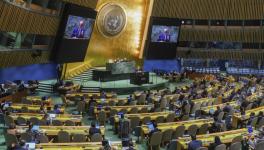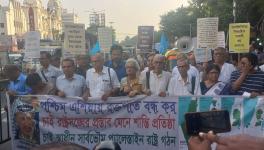Confirmed in mainstream sources: Syrian rebels possess and have used Chemical Weapons
Pulitzer Prize winning journalist Seymour Hersh wrote an extensive investigative piece last week featured in the London Review of Books, which details the Obama administration’s “cherry-picking” of intelligence related to the August 21 Damascus chemical attack. “Whose sarin?” was originally intended for the Washington Post, but neither the Post nor Hersh’s usual New Yorker Magazine published it – presumably because its allegations and conclusions are too explosive and embarrassing for those already heavily invested in the accepted narrative of D.C. official sources. Read the following bombshell revelation from the first paragraph:
Most significant, he [Obama] failed to acknowledge something known to the US intelligence community: that the Syrian army is not the only party in the country’s civil war with access to sarin, the nerve agent that a UN study concluded – without assessing responsibility – had been used in the rocket attack. In the months before the attack, the American intelligence agencies produced a series of highly classified reports, culminating in a formal Operations Order – a planning document that precedes a ground invasion – citing evidence that the al-Nusra Front, a jihadi group affiliated with al-Qaida, had mastered the mechanics of creating sarin and was capable of manufacturing it in quantity. When the attack occurred al-Nusra should have been a suspect, but the administration cherry-picked intelligence to justify a strike against Assad.
Hersh goes on to detail an intelligence community revolt, involving high-level officers, against the administration claim that only the Assad regime could have been responsible for the August 21 incident. Hersh has extensive intelligence and military contacts based on his decades long career covering war going back to Vietnam (it was Hersh that exposed the My Lai Massacre). His reporting of intelligence community push-back begins with the following:
But in recent interviews with intelligence and military officers and consultants past and present, I found intense concern, and on occasion anger, over what was repeatedly seen as the deliberate manipulation of intelligence. One high-level intelligence officer, in an email to a colleague, called the administration’s assurances of Assad’s responsibility a ‘ruse’. The attack ‘was not the result of the current regime’, he wrote.
In mid-November, Philip Giraldi, a former CIA officer who writes on foreign and defense affairs for The American Conservative first broke the story of a threatened mass resignation by top intelligence analysts over Syria chemical weapons claims. “Quitting Over Syria,” while written by an insider who keeps extensive intel community contacts, got no exposure in major network news, failing to reach the mass of Americans. Giraldi’s reporting was consistent with Hersh’s recent revelations:
With all evidence considered, the intelligence community found itself with numerous skeptics in the ranks, leading to sharp exchanges with the Director of Central Intelligence John Brennan and Director of National Intelligence James Clapper. A number of analysts threatened to resign as a group if their strong dissent was not noted in any report released to the public, forcing both Brennan and Clapper to back down. This led to the White House issuing its own assessment, completely divorcing the process from any direct connection to the intelligence community. The spectacle of CIA Director George Tenet sitting behind Secretary of State Colin Powell in the United Nations, providing him with credibility as Powell told a series of half-truths, would not be repeated.
The American public had no knowledge of this internal conflict and dissent within the intelligence community while it was happening, and few know of it today.
More surprising is that while the ongoing UN investigation was center stage throughout September, the final UN findings on chemical weapons usage in Syria were published this last Thursday (12/12), yet received little focus in major American media reporting or analysis. While major media has perhaps “moved on” – the UN report contains some damning information related to the rebels and chem weapons: “The United Nations Mission remains deeply concerned that chemical weapons were used in the ongoing conflict between the parties in the Syrian Arabic Republic, which has added yet another dimension to the continued suffering of the Syrian people,” the report says [emphasis LR's].
The report states that chemical weapons were “probably used” at five sites in Syria during the two-and-a-half year long conflict. Most significant is that at two sites, the victims were Syrian government soldiers, and at another, the victims were regime soldiers and civilians (for initial BBC reporting go here). While the purpose of the investigation was not to establish the culprit in each attack, the report identifies the victims in three out of the five incidents as regime soldiers. This is a tacit UN admission that the rebels possess and have used chemical weapons.
Even the generally pro-rebel and very establishment New York Times had to admit the following on Thursday:
Chemical weapons were used repeatedly in the Syria conflict this year, not only in a well-documented Aug. 21 attack near Damascus but also in four other instances, including two subsequent attacks that targeted soldiers, the United Nations said in a report released Thursday.
And concerning the first reported usage of chemical weapons in the entirety of the Syrian conflict, the NYT admits that Syrian soldiers were on the receiving end:
The report said the panel had corroborated “credible allegations” that chemical weapons were used in the first reported attack — a March 19 episode involving soldiers and civilians in Khan al-Assal in the country’s north.

A widely circulated image of an Al-Nusra fighter in Northern Syria. A highly sophisticated chemical riot control grenade can be seen, indicating outside state-sponsorship. This image and others, was the focus of a number of Syria weapons watch websites speculating whether or not the rebels had chemical weapons capabilities. (Photo taken by Jeffry Ruigendijk.)
For those that did their homework while questions of Syria chemical attacks were the hot topic in August and September, credible allegations of rebel chemical weapons are nothing new. Last May, Carla Del Ponte, a top UN human rights investigator and former UN Chief Prosecutor and veteran International Criminal Court prosecutor - was the first to accuse the rebels using Sarin gas against regime forces and civilians (see here, here, and here). Del Ponte’s assertions, based upon her information gathering team on the ground, caused a row in Europe, but it seems the only major American outlet to cover the story was the LA Times. During a Swiss-Italian TV interview, she was convinced enough to be very blunt in her assessment, saying, “I was a little bit stupefied by the first indication of the use of nerve gas by the opposition.”
Revelations of the deep divide within the U.S. intelligence community over the August 21 chemical attack and Obama’s push for intervention, along with the just release UN report confirming that CW were used against regime troops in the majority of attack sites, should get common sense Americans questioning everything they were ever told by establishment sources concerning chemical weapons and Syria.
Disclaimer: The views expressed here are the author's personal views, and do not necessarily represent the views of Newsclick
Get the latest reports & analysis with people's perspective on Protests, movements & deep analytical videos, discussions of the current affairs in your Telegram app. Subscribe to NewsClick's Telegram channel & get Real-Time updates on stories, as they get published on our website.
























